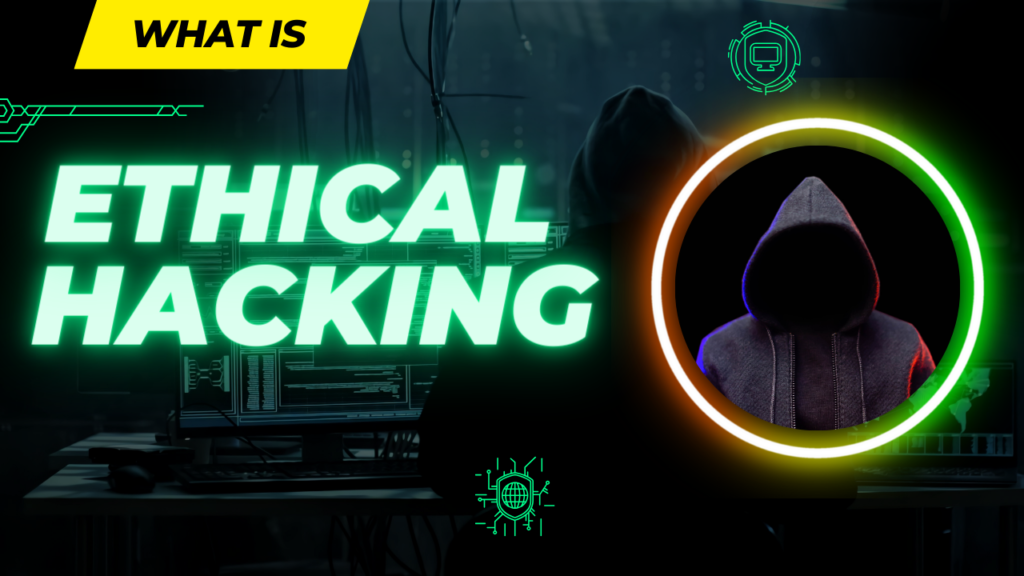
Table of Contents
Introduction:
Ethical Hacking. The dark shadows of cyber threats loom large. As the digital landscape expands, so do the vulnerabilities that can be exploited by malicious actors. Enter ethical hacking, the unsung hero of cybersecurity. In this blog post, we’ll delve into the realm of ethical hacking, deciphering its meaning, importance, and the pivotal role it plays in safeguarding our interconnected world.
Decoding Ethical Hacking: A Primer
Understanding the Concept
Ethical hacking, often referred to as penetration testing or white-hat hacking, is a cybersecurity practice where authorized professionals, known as ethical hackers or penetration testers, simulate cyberattacks on computer systems, networks, applications, or websites. The primary objective is to identify vulnerabilities and weaknesses before malicious actors can exploit them for nefarious purposes.
Ethical hackers essentially adopt the same techniques and tools as malicious hackers but with a fundamental difference – their actions are sanctioned and aimed at fortifying digital defenses rather than causing harm. This ethical approach distinguishes them from their black-hat counterparts who exploit vulnerabilities for personal gain, malicious intent, or cybercrime.
The Fine Line Between White Hats and Black Hats
The distinction between ethical hackers (white hats) and malicious hackers (black hats) lies in their intentions and adherence to legal and ethical standards. Ethical hackers operate within the bounds of the law, obtaining explicit consent from the system owners before conducting assessments. They aim to bolster cybersecurity measures, enhance resilience, and protect sensitive information.
In contrast, black-hat hackers engage in activities that are illegal and harmful, ranging from stealing sensitive data and disrupting services to deploying malware and ransomware attacks. The fine line between these two groups underscores the importance of ethical guidelines and legal frameworks governing cybersecurity practices.
Legality and Compliance
Ethical hacking is a legitimate and crucial component of cybersecurity, but it must be conducted within the confines of legal and ethical frameworks. Laws and regulations vary across jurisdictions, so ethical hackers must be well-versed in the legal aspects of their work. Obtaining explicit permission from the system owner or organization is essential to avoid legal repercussions.
Compliance with industry standards and regulations, such as the Payment Card Industry Data Security Standard (PCI DSS) or the Health Insurance Portability and Accountability Act (HIPAA), is another critical facet of ethical hacking. Ethical hackers must ensure that their activities adhere to the specific compliance requirements relevant to the systems or networks they are assessing.
In essence, ethical hacking is a carefully regulated and principled practice that serves as a proactive defense mechanism in the ever-evolving landscape of cybersecurity. By understanding the nuances of ethical hacking, organizations can harness its power to safeguard their digital assets and stay one step ahead of potential threats.
The Purposeful Pursuit of Vulnerabilities
Identifying Weaknesses Before the Malefactors Do
The essence of ethical hacking lies in its proactive approach to cybersecurity – finding and fixing vulnerabilities before they can be exploited by malicious actors. Ethical hackers systematically and methodically search for weaknesses in systems, networks, applications, and other digital assets. By actively seeking vulnerabilities, they help organizations stay one step ahead of cybercriminals, who often exploit weaknesses for financial gain, espionage, or other illicit activities.
The Role of Ethical Hackers in Fortifying Systems
Ethical hackers play a pivotal role in strengthening the cybersecurity posture of organizations. Their objective is not only to identify vulnerabilities but also to provide actionable insights and recommendations for remediation. This collaborative effort between ethical hackers and organizations helps create robust defense mechanisms, ensuring that potential entry points for cyber threats are addressed promptly.
Real-world scenarios have shown that vulnerabilities discovered by ethical hackers and addressed promptly have the potential to thwart large-scale cyberattacks, protect sensitive data, and preserve the integrity of digital infrastructure. In essence, the purposeful pursuit of vulnerabilities by ethical hackers contributes directly to the resilience and security of the digital landscape.
Real-world Examples of Ethical Hacking Triumphs
Ethical hacking has been instrumental in uncovering vulnerabilities in widely used software, applications, and platforms. Many technology giants, financial institutions, and government agencies have embraced ethical hacking as an integral part of their cybersecurity strategy. For instance, bug bounty programs – initiatives that reward ethical hackers for identifying and reporting vulnerabilities – have gained popularity, fostering a community-driven approach to cybersecurity.
One notable example is the collaboration between ethical hackers and major tech companies through bug bounty programs. This cooperative effort has led to the identification and patching of critical vulnerabilities in software and services, preventing potential security breaches and data leaks. Such triumphs highlight the positive impact of ethical hacking in creating a safer digital environment for users worldwide.
The Toolkit of an Ethical Hacker
Software and Hardware Arsenal
Ethical hackers, armed with a diverse toolkit, navigate the digital realm to uncover vulnerabilities and fortify cybersecurity defenses. Their toolkit comprises a combination of specialized software and hardware designed to simulate various cyber threats and attacks. Here’s a closer look at some essential components:
Vulnerability Scanners: These tools automatically scan systems, networks, and applications to identify potential weaknesses. Examples include Nessus and OpenVAS, which help ethical hackers pinpoint vulnerabilities that could be exploited by malicious actors.
Penetration Testing Tools: Ethical hackers use tools like Metasploit, Burp Suite, and OWASP ZAP to simulate real-world attacks. These tools aid in identifying vulnerabilities and testing the effectiveness of security measures.
Packet Sniffers: Tools like Wireshark capture and analyze network traffic, allowing ethical hackers to inspect data packets and identify potential security issues. This is crucial for understanding how information flows across a network.
Password Cracking Tools: Ethical hackers employ tools like John the Ripper and Hashcat to test the strength of password policies. By attempting to crack passwords, they assess the vulnerability of user accounts and systems to unauthorized access.
Forensic Tools: In the aftermath of a security incident, ethical hackers may use forensic tools such as EnCase or Autopsy to investigate and analyze digital evidence. This helps in understanding the scope of the breach and identifying the perpetrators.
Firewall and Antivirus Evasion Tools: Ethical hackers use tools like Veil-Evasion to test the effectiveness of firewalls and antivirus software. These tools help simulate advanced attack techniques that malicious actors might employ to bypass security measures.
Social Engineering: The Human Element
Beyond technical tools, ethical hackers understand the importance of the human element in cybersecurity. Social engineering involves manipulating individuals to disclose sensitive information or perform actions that may compromise security. Ethical hackers often use social engineering techniques to assess an organization’s susceptibility to phishing, pretexting, or other forms of human manipulation.
Constant Learning and Adaptation
The field of cybersecurity is dynamic, with new threats and vulnerabilities emerging regularly. Ethical hackers, therefore, engage in continuous learning to stay abreast of the latest developments. They participate in training programs, attend conferences, and obtain certifications to enhance their skills and knowledge. Certifications such as Certified Ethical Hacker (CEH) and Offensive Security Certified Professional (OSCP) are widely recognized in the industry.
Bug Bounty Programs: Incentivizing Ethical Hacking
The Rise of Crowdsourced Security
Bug bounty programs represent a paradigm shift in cybersecurity, transforming the way organizations approach vulnerability identification and mitigation. These programs leverage the power of crowdsourcing by inviting independent security researchers, ethical hackers, and enthusiasts from around the world to actively search for and report security vulnerabilities in exchange for monetary rewards or recognition.
Collaboration Between Organizations and Ethical Hackers
Bug bounty programs foster a collaborative relationship between organizations and ethical hackers. Instead of relying solely on internal security teams, organizations open their digital doors to a global community of cybersecurity experts. This collaborative approach not only broadens the pool of talent but also brings diverse perspectives and skill sets to the table.
By establishing channels for communication and disclosure, organizations create an environment where ethical hackers can responsibly report identified vulnerabilities without fear of legal consequences. This collaboration is built on trust, transparency, and a shared goal of enhancing cybersecurity.
Mutual Benefits for Both Hackers and Companies
Financial Rewards: Ethical hackers are incentivized by the prospect of financial rewards offered by bug bounty programs. The severity of the identified vulnerability often determines the bounty amount, providing ethical hackers with a tangible incentive for their efforts.
Recognition and Reputation: Beyond monetary rewards, bug bounty programs offer ethical hackers an opportunity to build and showcase their skills. Many organizations acknowledge and publicly recognize ethical hackers for their contributions, enhancing their professional reputation within the cybersecurity community.
Continuous Improvement: For organizations, bug bounty programs serve as continuous improvement mechanisms. By tapping into the collective knowledge of ethical hackers, companies can identify and address vulnerabilities before malicious actors exploit them. This proactive approach enhances overall cybersecurity resilience.
Cost-Effective Security Testing: Bug bounty programs offer a cost-effective alternative to traditional security testing methods. Instead of relying solely on in-house security teams or periodic third-party assessments, organizations can leverage the global community of ethical hackers to conduct ongoing, real-time security testing.
Challenges and Considerations
While bug bounty programs bring numerous benefits, they also present challenges. Organizations must establish clear guidelines for ethical hacking activities, define acceptable testing boundaries, and ensure that the responsible disclosure of vulnerabilities is followed. Additionally, the process of validating reported vulnerabilities and determining appropriate rewards requires careful consideration.
Ethical Hacking in Practice
The Stages of Ethical Hacking: Reconnaissance, Scanning, Gaining Access, Maintaining Access, and Analysis
Reconnaissance: Understanding the Terrain
Ethical hacking begins with reconnaissance, the phase where hackers gather information about the target system or network. This involves passive information gathering, such as analyzing publicly available data, DNS records, and social media profiles. Ethical hackers aim to understand the target’s digital footprint, potential entry points, and vulnerabilities.
Scanning: Identifying Vulnerabilities
In the scanning phase, ethical hackers actively search for vulnerabilities. They use tools like network scanners to discover live hosts, port scanners to identify open ports, and vulnerability scanners to pinpoint potential weaknesses in the target’s software or configurations. This stage is crucial for building a comprehensive understanding of the attack surface.
Gaining Access: Simulating Attacks
Once vulnerabilities are identified, ethical hackers move to the exploitation phase. Using penetration testing tools, they attempt to exploit weaknesses to gain unauthorized access. This stage mirrors the tactics of real attackers, testing the effectiveness of security measures and identifying potential points of failure.
Maintaining Access: Mimicking Persistence
Ethical hackers, having successfully breached the system, may explore ways to maintain access undetected. This phase simulates the tactics employed by advanced persistent threats (APTs) or skilled adversaries who aim to establish a long-term presence within a network. Maintaining access is critical for uncovering potential blind spots in cybersecurity defenses.
Analysis: Reporting and Remediation
The final stage involves thorough analysis and reporting. Ethical hackers compile a comprehensive report detailing the vulnerabilities discovered, the methods used to exploit them, and recommendations for remediation. This information is shared with the organization’s stakeholders, providing actionable insights for improving security measures.
Common Techniques Employed by Ethical Hackers
SQL Injection and Cross-Site Scripting (XSS): Ethical hackers often test web applications for vulnerabilities like SQL injection and XSS, which can be exploited to manipulate databases or inject malicious scripts.
Phishing Attacks: Simulating phishing attacks helps assess an organization’s susceptibility to social engineering. Ethical hackers craft deceptive emails or messages to test employees’ awareness and vigilance.
Password Attacks: Ethical hackers use various techniques, such as brute-force attacks or password cracking tools, to test the strength of password policies and assess the resilience of user accounts.
Network Sniffing: By capturing and analyzing network traffic, ethical hackers identify potential security gaps and vulnerabilities, including unencrypted sensitive information traversing the network.
Hands-on Examples of Ethical Hacking in Action
Web Application Security Testing: Ethical hackers scrutinize web applications for vulnerabilities, such as insecure direct object references (IDOR), security misconfigurations, and input validation issues.
Wireless Network Security Assessment: Assessing the security of wireless networks involves ethical hackers attempting to exploit weak encryption, unauthorized access points, or misconfigured settings that could compromise network integrity.
Social Engineering Assessments: Ethical hackers engage in social engineering tactics, such as pretexting or impersonation, to assess the susceptibility of employees to manipulation and gather information that could aid in an attack.
The Global Impact of Ethical Hacking
Ethical Hacking and National Security
Ethical hacking has far-reaching implications for national security, as governments around the world recognize the critical importance of securing their digital infrastructure. Ethical hackers often collaborate with national security agencies to identify vulnerabilities in government systems, critical infrastructure, and defense networks. By proactively addressing weaknesses, ethical hacking contributes to a nation’s cyber resilience, helping prevent cyber espionage, attacks, and potential breaches that could compromise sensitive information.
Cross-Border Collaboration in Cybersecurity
In an interconnected world, cyber threats transcend borders, requiring a collaborative approach to cybersecurity. Ethical hacking fosters international cooperation as cybersecurity experts from different countries work together to share insights, methodologies, and threat intelligence. Cross-border collaboration is crucial for staying ahead of global cyber threats, as the tactics used by malicious actors often span multiple jurisdictions.
Ethical Hacking’s Role in Shaping International Cyber Policies
The practice of ethical hacking plays a significant role in shaping international cyber policies. As governments and international organizations grapple with the challenges posed by cyber threats, the expertise of ethical hackers is sought to inform policy decisions. Ethical hacking can influence the development of cybersecurity standards, regulations, and international agreements, providing valuable insights into effective strategies for combating cybercrime and securing digital ecosystems.
The Evolving Landscape: Future Trends in Ethical Hacking
Artificial Intelligence and Machine Learning in Ethical Hacking: The integration of artificial intelligence (AI) and machine learning (ML) into ethical hacking tools is a growing trend. These technologies enhance the speed and efficiency of vulnerability detection, enabling ethical hackers to analyze vast amounts of data and identify emerging threats in real-time.
The Influence of IoT on Ethical Hacking Practices: The proliferation of Internet of Things (IoT) devices introduces new challenges and vulnerabilities. Ethical hackers are at the forefront of addressing these challenges, testing the security of IoT devices, networks, and ecosystems to prevent potential exploits that could have widespread consequences.
Ethical Hacking in the Age of Quantum Computing: The advent of quantum computing presents both opportunities and challenges for cybersecurity. Ethical hackers are exploring quantum-resistant encryption techniques and evaluating the impact of quantum computing on existing security protocols to prepare for the next phase of digital evolution.
Future Trends in Ethical Hacking
Artificial Intelligence and Machine Learning in Ethical Hacking
As technology advances, the integration of artificial intelligence (AI) and machine learning (ML) into ethical hacking practices is becoming increasingly prevalent. AI and ML technologies empower ethical hackers with advanced tools for automation, pattern recognition, and anomaly detection. These capabilities enhance the speed and efficiency of vulnerability assessment, enabling ethical hackers to analyze vast datasets, identify emerging threats in real-time, and respond proactively to evolving cyber risks. Machine learning algorithms can also assist in predicting potential vulnerabilities based on historical data, providing a more predictive and adaptive approach to ethical hacking.
The Influence of IoT on Ethical Hacking Practices
The rapid proliferation of Internet of Things (IoT) devices introduces new challenges and complexities to the digital landscape. Ethical hackers are at the forefront of addressing these challenges by focusing on the security of IoT ecosystems. Future trends in ethical hacking will likely involve specialized testing methodologies for IoT devices, networks, and platforms. As IoT becomes more integrated into daily life and critical infrastructure, ethical hackers will play a pivotal role in identifying and mitigating vulnerabilities to prevent potential exploits that could have far-reaching consequences.
Ethical Hacking in the Age of Quantum Computing
The advent of quantum computing poses both opportunities and challenges for the field of cybersecurity. Ethical hackers are gearing up to address the potential impact of quantum computing on cryptographic protocols. Future trends in ethical hacking may involve the development and evaluation of quantum-resistant encryption techniques. Ethical hackers will need to explore the vulnerabilities and threats posed by quantum computing to ensure that security measures can withstand the paradigm shift brought about by this emerging technology.
Continuous Adaptation and Learning
The landscape of cybersecurity is dynamic, with new threats and attack vectors emerging regularly. Future trends in ethical hacking will emphasize the importance of continuous adaptation and learning. Ethical hackers will engage in ongoing training, certification programs, and knowledge exchange to stay abreast of the latest developments in cyber threats and security technologies. This commitment to continuous improvement will enable ethical hackers to effectively address evolving challenges and contribute to the overall resilience of digital ecosystems.
Collaboration and Information Sharing
The future of ethical hacking will likely see an increased emphasis on collaboration and information sharing within the cybersecurity community. Ethical hackers from diverse backgrounds and geographies will collaborate to share insights, methodologies, and threat intelligence. Such collaborative efforts are essential for staying ahead of sophisticated cyber adversaries who often operate on a global scale. Open communication channels and community-driven initiatives will play a crucial role in building a collective defense against evolving cyber threats.
Conclusion:
As we navigate the intricate web of the digital age, ethical hacking emerges as a beacon of hope. In the hands of ethical hackers, vulnerabilities become opportunities for fortification, and weaknesses transform into strengths. The importance of ethical hacking cannot be overstated, and its role in securing our digital future is more crucial than ever. Embracing ethical hacking means embracing a safer, more resilient online world for individuals, businesses, and nations alike.








